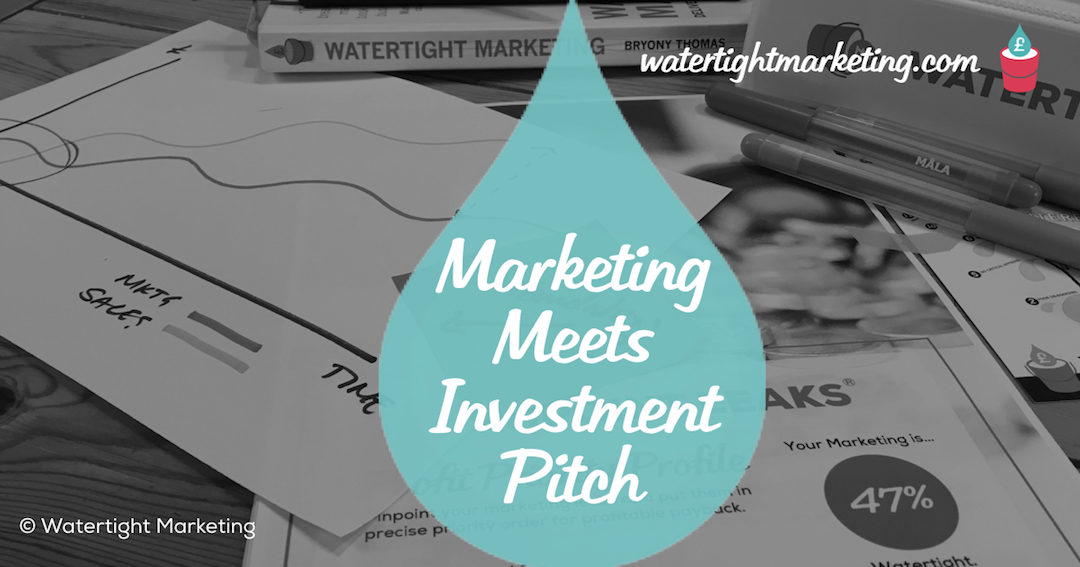The businesses that get the most from using the Watertight Marketing methodology to structure their marketing operations, and get a common language into their organisation, are typically those looking to seriously scale things up. This is where you have a proven product or service that’s starting to gain traction, but your systems need some attention to support the growth you have planned. For many, this means looking for investment. Two of our clients have secured £1m investment using the Watertight Marketing framework as part of their presentations. I’ve asked Certified Practitioner, Rachael Wheatley, to walk you through how you could do the same. ~ Bryony Thomas
You’re building a business and you’ve got to a stage where, to develop further, you need external investment to help fund the next phase.
This is the ‘Dragons’ Den’ point where you’re putting together a case to present to potential investors as to why they should spend their money on you and what they get in return.
What do you want from the meeting?
Firstly, decide what a good outcome would look like. It’s not a given that what you’ll walk out with is a cheque. There might be alternative next steps: a second meeting, or maybe some recommendations to take specific actions and come back.
So, in this meeting you want to:
- Spark their interest and show how much you believe in this business.
- Reassure them that it will be worth investing in you
- Demonstrate your credibility around what you do and that you can run a business well.
10 things to include in a compelling investment pitch?
There are several elements you’ll need to include in your pitch. Here are the ten things I’d put on the list for any client pulling this information together:
- Your vision and value proposition (what it is you’re selling, to whom and why: You can’t say you’re ready if you can’t say why you do it). < This is a marketing job
- Success and traction to date. < This is a marketing metrics job
- The problem you want to solve and the solution you’re providing. < This is a marketing job
- The target market and opportunity you’ve scoped. < This is a marketing job
- The competition, how you’re positioned, and your response to that. < This is a marketing job
- Revenue and business model (how you’re going to make money). < This has a marketing element
- Roadmap for getting there (business plan, sales and marketing strategies). < This is a marketing job
- The team you have in place, including any partnerships, and who’s going to deliver what. < Your marketing team roles are part of this, and a transferable marketing system makes succession possible!
- Robust financials (profit and loss to date, forecast, cashflow forecast). < Your marketing budget forms a part of this
- The investment you need, and how you’d use it, and what the investor would gain from it. < This has a marketing element
So, as you can see, there’s quite a bit of marketing expertise needed to get this right.
The key marketing expertise and investments you need to have put in place to enhance your pitch
From the list above (elements of a good investment pitch), there are four key areas where good marketing is essential and will support you:
- Clarity on what you’re selling, to whom and why. Knowing this is critical to the thinking behind a marketing strategy and plan. It’s the basis of a good value proposition.
- Understand your customers and prospects; who they are, (your ideal client profile, what characterises the organisation) and their sector challenges, opportunities and threats. Knowing the market in which they operate, their attitudes and a host of other information is the starting point for putting in place the right marketing. So it follows that if you don’t know enough about them, your marketing will be off kilter.
- Market research and analysis that provides insight. This links to the product or service you’re selling and knowing what problem it solves. And, understanding the marketplace well enough to know the size and shape of the opportunity, and how you’re positioned in it compared to your competitors.
- Have a strategy (3-5 year), and plan (12 -18 months) in place. Being able to articulate your plan is essential. Even better if it’s already being implemented and you’re gaining some success. Investors prefer for you to already have traction, already have some results. It reassures them that you have the wherewithal to grow the business already, and they’ll get return for their investment.
Having a line on your plans that simply says ‘marketing’ won’t cut it. Using the Watertight Marketing methodology to map that expenditure to every step of the sale demonstrates and clear and considered rationale, and a path to profitable payback. And, that’s what they’ll be looking for.
- Related post: Six steps to a strategic review of your marketing budget
Two less obvious ways marketing supports your investment pitch
There are also two more nuanced areas that may not immediately strike you as marketing-related, but can be a critical differentiator:
- Marketing yourself
- Having a considered and structured marketing strategy and plan in place that you are already delivering on.
Why marketing yourself, as the spokesperson, is critical
To deliver a good pitch, you’re going to need to be good (or get good) at marketing yourself. This is often not easy for business owners; it feels uncomfortable to be blowing your own trumpet. The way to do it well is to show them you believe in the business, be clear about why you’re doing it, and demonstrate that there is a problem that you’re solving.
Build a personal platform: You’ll need to consider stepping up the marketing the founder or the CEO of your organisation in the months ahead of a pitch. Securing some credible press coverage, awards, and being highly visible online can stand you in good stead, with investors having heard of you before you even walk through the door.
Find your voice: It may be worth investing in training or coaching in presenting and speaking. Both in terms of how you present information (yep, that’s marketing again) and how you present in the room. Know your business; the financials, the plan and your vision (inside out) so that when they ask the difficult questions you know the answer. This will help you prove your credibility.
Practice the pitch. And as many times as possible. Make sure it doesn’t feel scripted, but you’re in charge of what you want to say. If you know your stuff, and that feels comfortable, it’s easier to deal with nerves.
Systems allow for succession and scale
Where many a pitch falls short, is in not demonstrating how the organisation will cope with growth. If the secret sauce for your success is in your head, you’ll never get people to part with their cash. You have to show how the organisation would continue to thrive if you fell under a bus, or if any of your key people left. This is why ‘make it up as we go along marketing’ simply won’t cut it. Using a proven framework, like Watertight Marketing, that’s backed up with training courses any new people could go on, and network of quality-assured experts who can step in to support at any time, shows that you have this covered.
The three guiding principles for marketing that supports your investment pitch
if I were to distil this into three golden rules for marketing to support your investment pitch, I’d say:
Principle 1) Systems set you free: If it’s a documented process it can be passed on to another management team (mitigating the risk of things falling down if there’s a change in your senior executives).
- Related post: Why you can’t build a marketing strategy one tactic at a time
Principle 2) Always provide a plan that maps directly to profit & purpose: If the investment includes funds for marketing and sales to grow the business, many investors will be cynical of how that money will be spent. They can easily think it will be frittered away on things that will not directly drive sales. At Watertight Marketing, we help clients do this in a highly visual way of quickly showing where the investment will be spent and why. And demonstrating the activities you’ve put in place help support the customers buying journey at each stage, i.e. that there’s a purpose to your plan.
- Related post: The marketing task for every step of a sale
- Related post: What shape is your marketing budget?
Principle 3) Remember that potential investors are an audience for your marketing: In the run up to a pitch, it’s worth thinking about switching some spend to activities that will drive visibility, even though they will not in themselves drive sales. This suggestion might seem to be contrary to the Watertight Marketing methodology, but there’s a really good reason why it’s worth considering. Your potential investors are now part of your ‘market’ and audience, so with a bit of judicious research of the people likely to be in the room, if you sponsor something in a place you know they’ll hang out (their local golf club tournament, a well-placed advert in the trade press you know they read or sponsorship of some awards), you’ll be on their radar even before you meet them in the pitch.
© Watertight Marketing Ltd

Rachael Wheatley
Managing Director, Watertight Thinking
Rachael brings over 30 years’ of marketing experience, with a particular focus on building and developing effective marketing teams that are able to act as a strategic driving force across an organisation. She has worked with Watertight since 2014 as a Master Practitioner and joined the business as MD in 2022.


